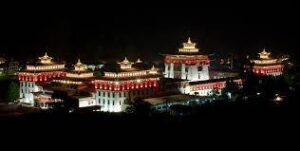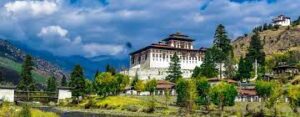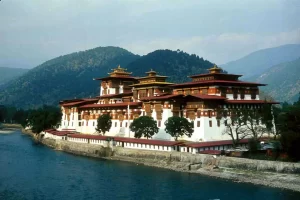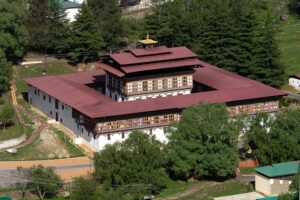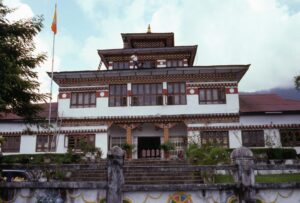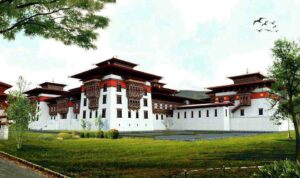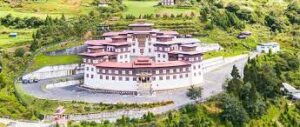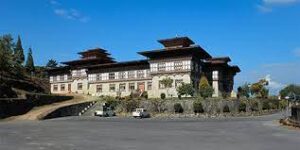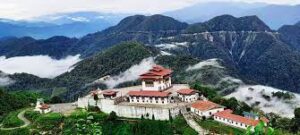1. Tashichho Dzong
Fortress of the Glorious Religion’ or ‘Fortress of Auspicious Doctrine’, or popularly known as Thimphu Dzong, is an impressive structure that houses the throne room and offices of the king, the secretariat and the ministries of home affairs and finance.
2. Paro Dzong
it was built in 1644 under the order of Zhabdrung Ngawang Namgyal, the holder of Drukpa- Kagyud Buddhist School, and the unifier of Bhutan. This dzong has been used on various occasions to protect Paro from the invasion of Tibet.
3. Punakha Dzong
the palace of great happiness or bliss, is the administrative centre of Punakha District in Punakha, Bhutan. The dzong was constructed by Ngawang Namgyal, in 1637–38. It is the second oldest and second largest dzong in Bhutan and one of its most majestic structures.
4. Wangdue Phodrang Dzong
built in 1638 that dominates the district. The name is said to have been given by Ngawang Namgyal the 1st Zhabdrung Rinpoche, who was searching for the best location for a Dzong to prevent incursions from the south. At the chosen spot, the Zhabdrung encountered a boy named Wangdi playing beside the river and hence named the dzong “Wangdi’s Palace”.
5. Haa Dzong
(Wangchuk Lo Dzong) Haa, Bhutan (also referred to as Haa Dzong). Built by Kazi Ugyen Dorje, the Drungpa of Haa, in 1913. The central building contains a shrine looked after by caretaker monks, the rest of the complex currently houses army offices.
6. Gasa Dzong or Gasa Tashi Tongmön Dzong
near Gasa is the administrative center of Gasa Dzongkhag (district) in the northwestern region of Bhutan.The Dzong was built in the 17th century by Tenzin Drukdra the second Druk Desi over the site of a meditation place established by Drubthob Terkungpa in the 13th century. The Dzong was constructed as a bulwark against attacks from the north and named Tashi Tongmön Dzong.
7. Trongsa Dzong
is the largest Dzong fortress in Bhutan located in Trongsa (formerly Tongsa) in Trongsa district, in the centre of the country.Trongsa Dzong is closely connected to the royal family. The first two hereditary kings ruled from this dzong, and tradition still dictates that the crown prince serve as Trongsa penlop before acceding to the throne.
8. Jakar Yugyal Dzong, or popularly known as Jakar Dzong
is believed to be constructed by Lam Ngagi Wangchuck (1517 – 1554), a Tibetan, who came to Bhutan in order to spread the Drukpa Kagyupa Buddhist order. Oral legend had it that a white bird once flew away and perched on where the Dzong stands today and a group of Lamas and the elders considered it was a good omen then, they left the old site and moved to the new one at the eastern area of the Bumthang Valley.According to some sources, the Tibetan military attacked the Dzong thrice. Phuntsho Namgyel, the ruler of Tsang in Tibet, twice sent an army to destroyed Zhabdrung in the 17th century but was defeated. The third subjugation concurred under the dynasty of the 3rd Desi, Minjur Tempa. It was believed as a difficult battle that was only won with the arrival forces of Lam Ngawang Rabten. After the victory, the Dzong, we know today, was renamed as’Jakar Yugyal Dzong’ and in English, it means ‘ the Victorious Fortress of the White Bird’.
9. Mongar Dzong
is the fastest-developing dzongkhag in eastern Bhutan. The road approaching Mongar is one of the most spectacular journeys in the country. It passes over sheer cliffs and through beautiful fir forests and green pastures.
The Dzong in Mongar was built (1930), it was constructed the same way as all earlier dzongs, without plans or nails.
However, unlike the earlier dzongs, that are located in strategic positions, Mongar Dzong is located on a small gently sloping area just above the town. A visit to Mongar Dzong demonstrates how traditional Bhutanese architecture has continued to thrive through the centuries.
10. Popularly known as Lhundub Rinchentse
this mighty fortress sits upon a hill overlooking the Kurichu River. It was constructed in 1654 by the Trongsa Penlop, Chogyal Minjur Tempa. Today the dzong is the administrative and the religious centre of the district. It houses many sacred artifacts that were installed by the 4th Druk Desi Tenzin Rabgay.
11. Trashigang Dzong
‘The Fortress of the Auspicious Hill’ was built in 1659 to defend against Tibetan invasions. This imposing fortress is strategically situated high atop a spur overlooking the Dangmechu River.
According to legend, it is said that upon seeing the Dzong, invading Tibetan armies remarked that the Dzong was “not on the ground. It is a “Sky Dzong” before retreating. It has been the political stronghold of Eastern Bhutan for over 300 years.
Mount Meru is the site of the palace of the Druk Chhoglay Namgyal, which translates to “Victory of Bhutanese over enemies in all directions”. It is accessible only from the north, via a narrow road, paved by blasting through the cliff-side. Due to its location, Trashigang Dzong is one of the most strategically placed Dzongs in Bhutan. The present Dzong was enlarged by Dzongpon Dopola in 1936.
12. Trashi yangtse Dzong
One of the newest dzongkhags in the country, Trashi yangtse was established as a distinct district in 1992. With its wealth of natural, historical and cultural resources Trashi yangtse is a destination that visitors to Bhutan will never forget. Trashi yangtse is an ethnically and culturally diverse district. The people of the region have developed incredible skill at woodworking and paper making. The items they produce such as traditional wooden bowls are prized throughout the country.
13. Samdrup jongkhar Dzong
is the newest dzong built in the country which is built on strategic locations atop mountains or between rivers, the dzong is built on a flat and fairly wide open area unlike other dzongs in the country. The dzong serves as the administrative center of the district.
14.Samtse Dzong,
During 1970s Samtse was created as the Dzongkhag Headquarters and the present administrative unit was established. Presently Samtse Dzongkhag has an area of approximately 1309.1 square kilometers and has two Dungkhags (Dorokha and Sipsu) and 15 gewogs.
15.Sarpang Dzong
was created as Dzongkhag (district) with the appointment of/alteration of the term Chichab to Dzongdag in 1973. In 1975, the District Administration was shifted to Gelephu where the old Dungkhag Office now stands
16.Dagana Dzong
In 1951, Daga Trashi Yangtse Dzong was built on a ridge overlooking a valley by Drugda Namgyel with a command from Zhabdrung Ngawang Namgyel to bring the area under control and to defend the country from the invading armies from south.
Daga Trashi Yangtse Dzong is one of the oldest Dzongs in the country. Among other sacred relics, the Dzong houses a buffalo horn measuring about 4’5”. The horn is believed to have been discovered by Daga Penlop Tempa Thinley in early 16th century.
17.Chukha Dzong
Chukha Dzong is one of the newest dzongs in Bhutan. It was consecrated on March 9, 2012 by the Chief Abbot and the inauguration ceremony was graced by Queen Jetsun Pema. The ground works for the dzong construction began in 2002 but the government halted the construction as the area is found to be unstable. Construction subsequently resumed in April 2006. The dzong structure is a blend of traditional architecture with a touch of modernity. Chhukha Dzong is located at Chhukha Dzongkhag (district), the entry point into western and central Bhutan from India.
18.Zhemgang Dzong
was founded by Lama Zhang Dorje Drakpa in the 12th century. Zhemgang Dzong stands on top of a ridge that rises sharply from Mangde Chhu, facing the village of Trong and Zhemgang town. Lama Zhang Dorje Drakpa, a renowned scholar-sage of Drukpa Kagyu school of Buddhism, originated from Tibet and travelled to present Zhemgang in 1163. Lama Zhang set up a hermitage on the present site of the Zhemgang Dzong and settled there for many years. In 1655 CE, a single storey dzong was built on the hermitage to defend against invaders led by Choestse Penlop.
19. Tsirang Dzong
serves as the administrative centre for the Tsirang district. Unlike most of the dzongs in Bhutan, Tsirang Dzong does not house the monastic body. The dzong is located half a kilometre from Damphu town and it will take about 2 hours 30 mins from Gelephu town. The construction of the dzong began in 2004 and was completed in 2008. Like the newer dzongs in Bhutan, Tsirang Dzong was built on flat land. From the dzong, you’ll get an amazing view of Khikhor Village.
20. Pemagatsel Dzong
Pemagatshel literally means the “Blissful Land of Lotus”. It is situated at the South- Eastern part of Bhutan, covering an area of about 1,023 square km with the population of 23,800 and 4,448 household according to the recent survey. This is the only eastern Dzongkhag where no other dialects are spoken except Tshangla. The district has its own special tourist attractions. Situated upon a dagger-shaped mountain, Yongla Goenpa is one of the oldest and holiest shrines in Eastern Bhutan.
Bhutan is home to 25 dzongs, which are significant structures serving both administrative and religious purposes throughout the country
Zhabdrung Ngawang Namgyal is credited with building 5 major dzongs during his reign in the 17th century. These dzongs were pivotal in unifying Bhutan and establishing its administrative and religious systems.
The dzongs he constructed are:
Simtokha Dzong (1629)
Punakha Dzong (1637)
Wangdue Phodrang Dzong (1638)
Paro Dzong (Rinpung Dzong) (1644)
Tashichho Dzong (1641, later expanded)

